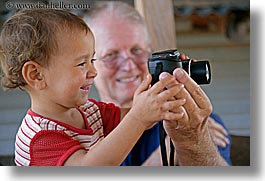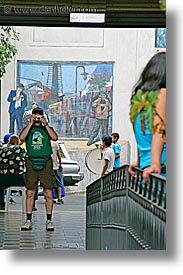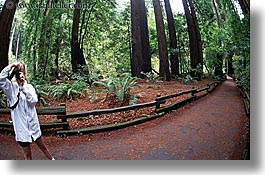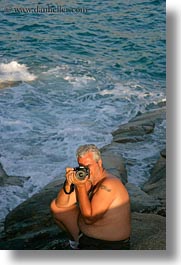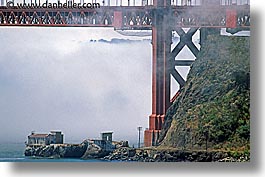|
Markers indicate locations for photos on this page.
Accuracy responsibility of Google Maps
Google Map Goes Here
If you see this text, the map is still loading (or there's an error). |
In the photo business, the greatest myths are those involving model releases. If you have ever considered selling (or licensing) photos on your own, or through a stock agency, you've probably been told that photographers need "model releases" to sell photos of people, and "property releases" to sell photos of buildings and the like. Some stock agencies actually reject images unless these photos have releases. While it's true that model release are necessary for certain situations, the actual laws about these issues are complex and imprecise, and because people want quick, simple and definitive answers, they over-simplify the root ideas behind the law, and contort them into inaccuracies that now circulate the internet today. Yet, they perpetuate because these myths cause no harm. If there's no harm, what's the problem? Simply, photographers are losing enormous opportunity by not trying to sell the images they don't have releases for. Furthermore, they are going to great lengths to get releases they don't need. Most photographers could continue to have very successful businesses without ever getting model releases, all while doing exactly what they are doing today. Sure, releases are important for many types of publishers, so if you do get releases for their benefit, you can expand your buyer base by getting them. But it's a proportionally smaller market than people think, and the minimally incremental income is unlikely to offset the time, effort and resources necessary to properly obtain, manage and catalog an ever-growing inventory of model releases. Keep in mind that if you do have a release for an image that your buyer depends on so they don't get sued, they may still pass on the image if the model's contact information is out of date or the release is perceived to be risky for any reason. So, ask yourself how much time do you want to invest in managing this database for a slice of business that, despite what the internet rumormill would have you believe, is quite small.
Since the market of buyers that can buy unreleased images is enormous,
it's worthwhile knowing the real facts about model releases so you can
optimize your financial opportunities with all your images..
First, as most people know, publishing news about people—and thus, showing pictures of them—does not require a model release. Accordingly, newspapers buy photos from people, either from their own paid staff of photographers, or from people in the general public. In both cases, neither the newspaper or the photographer (person selling the photo) needs a model release. Profit has nothing to do with it. The photo can be sold for a lot of money, and the newspaper can sell ads that are placed next to that to that photo. It can be placed on the newspaper's website that's behind a pay wall. So, selling a photo (and making a profit doing so) to a newspaper also does not require a release. Furthermore, the newspaper is allowed to make money (even a lot of it), even directly from that very same photo. It can place highly paid advertisements next to it, or put it on a website that requires a paid subscription. Profit from either the sale of the photo, or the use of the photo, has absolutely no bearing on whether permission is required (e.g., a model release).
In summary, the law does not require you to have any knowledge of the buyer or their intended use of a photo, so you are always allowed to sell photos without a release. And this is the case whether the buyer is a newspaper, an ad agency, a non-profit company, a television network, or an individual person. The act of selling photos never requires a release.
The legal case that most legal analysts point to is Corbis vs. James Brown. While this case was never adjudicated because the parties ultimately settled out of court (after appeals that didn't appear to favor either side), my interviews with legal scholars, reporters and judges who were familiar with this case felt that the case would not have changed the current law—that sellers have any liability for how publishers use (or misuse) images of others. The primary issue they cite is the countrary argument: if sellers were in the position of being held accountable for how a buyer published an image, publisher's would no longer bear such responsibility, and the rate of violations would skyrocket. If someone tried to bring a claim against the publisher, they would point to the Corbis case as precedent. That is, if someone sold them the image to publish, it must have been ok to publish. If it wasn't ok, then it's the seller's fault. Not only do courts not want such a scenario to take place, but courts also recognize they don't want non-liable parties in a position of making complex legal decisions on behalf of people they don't represent. Therefore, all legal analysts I've ever interviewed on this subject feel confident that the Corbis case would not have gone against them. That there is no other case where a seller was held liable for how a publisher used an image, it's reasonably assured that making an image available for sale does not require a model release. This includes any and all forms of publication and media, whether it's traditional print or online formats, including personal web pages, photo-sharing sites, social media sites, stock photo sites, or anywhere.
One obvious test is whether you can even identify the person in the first place. If you can't—for whatever reason—then it's a moot point. The back of someone's head is an easy example. You can also pixelate their face, or block out their eyes, or many other methods. So to even consider whether a release is required, the subject has to be recognizable. As for "making money," consider companies that sell books, magazines, newspapers and other forms of news media. While the content of their media may be editorial in nature (which doesn't require a release), the promotion of their products is commercial in nature. Just because a company may be promoting its editorial product, that suddenly doesn't trigger the need for a model release. Promotion is a commercial act, but simply doing so does not directly imply that the person used in the image is a supporter or advocate. Consider how Time Magazine may promote itself by showing the cover of an issue that features a celebrity. Consent is not required from that celebrity simply because the photo is used to promote the magazine, which is also a for-profit product. So again, "commercial use" does not itself trigger the need for a release.
But what about the promotion and advertising for the book? Both of those are "commercial" in nature: profits are made, and the book itself is a product. Again: promotion is "commercial use." Full Stop. So, one would think that Rush would have his lawyers find any legal position possible to stop or slow down the supply chain, from the photographer to the stock agency to the publisher. Yet, there it is in full color, used to both promote and advertise the book. The reason a release is not required is because this photo—or most any photo—would not cause a common person to believe that Rush is an advocate or sponsor of the book. (If there were a photo of Rush standing proudly next to a poster sized replica of the book, shaking the hand of the book's author, then such a photo could suggest he advocated the book. Then again, the existence of such a photo would be unlikely, and if it were, then he probably wouldn't be filing a claim about his publicity rights being violated.) In short, the "advocacy" question is not satisfied simply because photos are displayed. There has to be more context to imply advocacy.
Once again, this is a clear example of how and why courts couldn't have ruled against them. The seller didn't need to know what the publisher was going to use it for, and it turned out, this use wouldn't have required a release. Good thing the courts didn't put them in a position to have had to guess. And that's exactly how this image was found and purchased. This particular use of the image was commercial in nature, and didn't need a release. And the same would have been true if it were a non-commercial use as well. But, be careful not to draw the wrong conclusion from this statement: Non-profit companies often believe they can use photos of people in their materials because they are implicitly "non-commercial." But again, that's not the determining factor. How would you feel if your photo was used to promote a political organization that you vehemently opposed, especially those that advocated a social issue such as gun control or abortion? The organizations that promote such points of view are non-profit organizations, and the First Amendment gives those groups protection to publish their points of view. But they still need consent from people that they present as supporting those points of view. If they violate those rights, they could be liable for damages, which courts can impose, regardless of their non-profit status. The moral of the story is, take "commercial use" out of your vernacular, and only focus on the "advocacy" question. And while that's the right place to start, such assessments are not always easy; people disagree on specific cases and argue incessantly. As a photographer or as a seller of imagery, none of these are your economic or legal concerns; they are solely the concern of those who publish images.
There are several aspects to all this, each of which are separate issues. Regarding art (whether prints or online presentations), these are protected forms of expression already. You never need a model release to sell art of any form, including photographic prints. The fact the "product" is a photo itself is oddly irrelevant—the product being sold is separate from an advertisement used to promote that product. More on "artwork" is below. As for self-promotion, this is also a nuanced distinction. Images used to "demonstrate" the artist's work is different from those used to promote someone. This is easier to understand when you look at the work of other craftspeople, such a sculptor or a painter. In those case, it's easy to see that photos of their works are universally interpreted as "examples" of the artists' work. If the painting or sculpture happens to be of a person—even a recognizable one, the general public would not necessarily perceive those subjects as advocates for the artists. The same is true for photographers' works. Such an assertion would require text, often in the form of a quote praising the photographer's work. That context would require consent from the person depicted. See the next section.
The one thing to be aware of, however, is that sometimes photographers take pictures of people in special, "closed sessions," where an agreement was made ahead of time—before the photo was taken. If a subject posed for a photographer with the pre-arranged agreement that the photos would not be used in a portfolio or any other manner, than that agreement takes precedent. (Of course, a new agreement, such as a model release, can supersede it.)
While trademark violations are not unusual, it is exceedingly rare for one to result from the use of a photograph of any sort. It is almost always the result of using a logo or brand name. All concerns regarding trademark violations—especially those involving photos of buildings or any other kind of real estate or physical property—are entirely unfounded. It is impossible for a photo of a Coke bottle to cause a common person to suddenly think that the Coca Cola company supports or advocates a freelance photographer in Topeka, simply because he put a photo of it on his web page, or sold a print of it. If the photographer sold such an image to a publisher, and the publisher's use of the image implies that it had a unique and special business relationship with Coke, the risk of a trademark infringement claim rises for that publisher. No one else. The history of the "property release" stems from a single bit of misinformation long ago: Certain physical structures, such as the Golden Gate Bridge and the Transamerica building in San Francisco are based on designs that happen to be registered trademarks. And, the owners of these designs are known to be litigious in protecting their marks from misappropriation by other businesses, seeking to capitalize on their recognition value. And yet, none of those cases have ever involved photographs of such designs. Still, for a brief period of time, some publishers feared publishing photos of such places would put them at risk. So, they told photographers "we can't accept these images without releases." Unfortunately, they were unclear in stating that they needed releases for the use of the trademarks, not the buildings themselves.
Today, many publishers and stock photo agencies require property releases for photos of buildings, but not a single such document has any legal standing. Since the worthless document causes no harm, no one has had much incentive to question it, and the practice continues. To be crystal clear, property releases are not required to sell or resell photos of buildings and other real estate or physical property of any sort, including land, pets, livestock, homes, etc. If something happens to be a registered trademark (building or otherwise), then the publisher will already be quite aware that they are the ones that need to obtain permission from the trademark owner (which may not even be the building owner). Any permission obtained by the photographer would be entirely useless to the publisher. For more, see Photographers' issues concerning trademarks and photography.
To initiate this restriction, the owner has to proactively do something. such as make signs, print it on tickets, or verbally tell you. The key fact is that you're not prohibited by default. Sometimes, photographers will seek permission ahead of time, and this is not only unnecessary, but invites more problems than it's worth, or is necessary. This is not a simple matter of being courteous—the mere request on its own has itself an additional set of implied consent conditions that really complicate matters, and this applies in both cases of whether they grant or restrict that permission. (This is a complex matter of law that I won't get into, but it edges into the area of privacy rights.) So, unless and until you are told not to take pictures in advance, you can shoot photos on private property and you can sell those photos legitimately. (See later section on "ownership.")
Again, people argue frequently about whether such depictions are, in fact, artistic in nature, which leads to a complex argument: is it art, and if not, is it a promotion, and if so, is it the type of promotion that should have required consent from the person in the photo? There are a lot of "ifs" there. While these are all good questions, the reality is that no one has ever successfully won the argument that a model release was necessary for a photo that was used in a book, in an art gallery, or at a fair, or any of the items in the above list. In short, the law is on the side of the First Amendment by default - a claimant bears the burden of proving otherwise, and that's a difficult and very expensive bar to clear. While this is indeed a very deep and complex subject, those wishing to seek quick answers can feel relaxed: "don't worry. You're fine." For for more info, I encourage you to read this. You might also wish to read Personal Privacy and Model Releases (Saturday, April 12, 2008).
The same thing is true of pictures taken on (or of) people's property.
They think that because it's their house, or their private event, or
their pet, that they have the rights to the photos. They don't. Nor
can they stop the photographer from publishing those photos. Non-humans
do not have inherent rights, unless protected by trademark or copyright.
As an active photographer, understand that most people are entirely uninformed about model releases, and factor this into your business dealings. You will be told by many—publishers, stock agencies and others on the internet—that model (or property) release are required before selling or buying photos, or for accepting your images into a stock agency. Despite their being wrong, this is the way of the world, and you can only do what they ask, or don't play. But don't underestimate the sales potential of your unreleased images, and the large market of buyers who don't make such demands. For those with interest in reading the details, I have many articles that answer all the technical questions, like this one and this one. I also wrote a book called, Photographer's Guide to Model Releases.
Click to recommend this page: |
|


